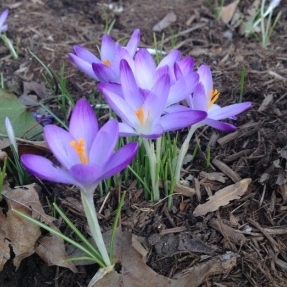The Gardener's Calendar
SPRING
March - May
Apply an all-purpose slow-release fertilizer to perennials and shrubs in late March to mid-April
Remove any additional leaves that fell through the winter
If deer eat your crocuses and other bulbs, start using your deer repellant of choice as flowers emerge. Continue to apply as needed to plants deer love
Add a soil acidifier around acid-loving plants such as hollies, azaleas, and rhododendrons in March
Cut back any perennials left over from the fall
Start irrigation system back up
Prune any dead branches out of roses, hydrangeas, and other sensitive shrubs
Apply preventative fungicides to any plants that suffer from serious spring fungal infections before rainy weather sets in
Begin training climbing vines as the spring growth spurt hits
Lawn application Round 1 is applied in March
Spring annuals and container arrangements can go in between late March and late April depending on the desired plants
Put down pre-emergent herbicide in planting beds in late March to mid-April
Put down a fresh layer of mulch – be sure to keep it from touching tree trunks or burying shrubs bases
Redefine bed edges
If evergreen trees need to be fertilized, early March is a good time
Overseed thin lawns and spot-seed bare spots in March
Divide perennials as needed when they have emerged enough to find them easily but before the leaves have opened up much – this will be about 3-4” high for most plants
Begin pulling or spraying weeds as they emerge (be sure to exercise caution and read all labels when using herbicides)
Lawns are ready to be mowed in mid to late April
Lawn application Round 2 is applied in late April to early May
Put peony supports up while the new growth is still short – as the leaves expand they will hide the hoops
Replace plants that didn’t survive the winter
Start using slug control around hostas in May
Pinch back leggy perennials that bloom in mid-summer by the end of May
Deadhead spring-blooming perennials as needed
Summer annuals can be planted in mid-May after the last freeze date
Prune spring-blooming shrubs such as forsythia and vernal witch hazel as soon as they’re done blooming
SUMMER
June - August
Significant tree pruning can be done in early June after the rainy season and before the weather gets hot
Plant summer annuals in the ground and containers in June if you didn’t in May
Pull and spray weeds through the summer (be sure to read all labels for herbicides)
Deadhead perennials and roses to extend bloom season
Stake leaning perennials
Cultivate mulch for a fresh look
During long dry spells, water drought-sensitive plants
Cut back asters and other tall, fall-blooming plants to keep them from getting overgrown in the fall
Trim unruly perennials like catmint and Russian sage to keep them from covering paths and other plants
Lawn application Round 3 is applied between mid-June and mid-July
Keep fountains filled and containers watered in the hot sun
Prune shrubs as they get unruly
FALL
September - November
Seed new lawns between mid-September and mid-October
Pull and spray weeds through the fall (be sure to read all labels for herbicides)
Aerate and overseed lawns
Lawn application Round 4 is applied in September
Starting in mid-September fall annuals are available for containers and in-ground planting
Prune shrubs as they get unruly (if you prune spring-blooming shrubs in the fall, you will remove some or all of the next year’s flowers)
Cultivate mulch for a fresh look
Continue to deadhead perennials, roses, and hydrangeas
Cut back many perennials as they drop their leaves and turn brown
Leave grasses and other perennials with winter interest – little bluestem and blue false indigo can add a lot to the cold months
Do any lawn over-seeding or seed new lawns by the end of September
Divide and transplant perennials in mid-September and October
Plant bulbs in October and November before the ground freezes
Lawn application Round 5 is applied in October
Winterize irrigation systems in October and November
Sensitive heirloom rose varieties should be tied up with leaves as insulation
Disconnect and drain hoses before the first freeze
Leaf removals start in October and extend into December
Deep root tree fertilization happens in November
WINTER
December - February
Put up holiday lights, decorations, and container arrangements, and take down once the holiday season is over
Put reflective markers at driveway edges to help snow plows stay on track
Watch out for winter damage to trees and shrubs – broken tree branches should be properly pruned before spring
Cover or bring in outdoor furniture, cushions, and delicate planters
Clean and repair outdoor furniture
Review garden plans and dream up ideas for next year








